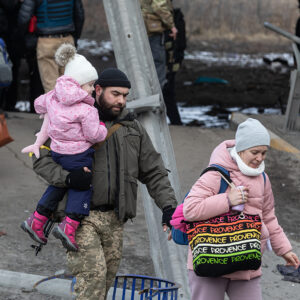The frontlines may be in Ukraine’s Donbas, but as war drags on it is becoming more than just a military mobilization. The philanthropic sector is also at war in Ukraine. And, when the shooting stops, the sector will be central to rebuilding.
But we need to confront the limits placed on the philanthropic sector’s ability to respond. And we must look in the mirror to see how civil society is under threat and where philanthropy took its eyes off the ball in the run-up to this war.
First, the response from the philanthropic sector has been enormous and impactful — despite regulatory hurdles in the United States and elsewhere.
At least 6 million Ukrainians are now refugees across the region and nearly two-thirds of Ukraine’s children have been displaced. Hundreds of thousands of Russians, too, have fled. Thankfully, a global network of aid organizations has responded swiftly, with expertise, flexibility and enormous resources, ranging from established nonprofits like the International Rescue Committee to legions of volunteer efforts to support and accommodate those fleeing hostilities. In total, more than $1 billion in philanthropic support has been mobilized to date.
But while Ukraine, Poland and other countries have cultivated strong philanthropic infrastructure to receive donations from abroad, strict regulations in places like Canada have created hurdles for citizens making international donations. This includes the onerous micromanagement of how Canadian-operated nonprofits can direct funds abroad. Even with generous official humanitarian aid from the Canadian government, this leaves millions of dollars in philanthropic funding to Ukraine and Ukrainian refugees potentially unclaimed.
Second, the global philanthropy environment is poorly understood by policymakers and remains highly volatile — particularly in regions where civil society is weak.
The most recent Global Philanthropy Environment Index from the Indiana University Lilly Family School of Philanthropy provides a useful framework to help global decision-makers understand where philanthropy is succeeding and why. It also reveals that more than 30 nations and economies face a shrinking political space for philanthropy.
This includes critical nations like Hungary, where volunteers and nonprofits are helping accommodate Ukrainian refugees but where the government has scrutinized foreign funding and does not provide a favorable political environment or tax incentives for charities. For civil society to thrive, charities must be free from burdens like these.
Third, philanthropy didn’t cause the war, but it could have done more to prevent it. The philanthropic sector sets priorities. And there are consequences to those choices.
Amid the backdrop of the war in Ukraine, the philanthropic sector’s fading concern for international conflict and weapons of mass destruction now seems misguided — as does recent news that the MacArthur Foundation would cease its philanthropic support for nuclear disarmament. This is particularly troubling given philanthropy’s role in shaping the international community and the norms that are now being violated by Vladimir Putin’s aggression.
Could philanthropy have prevented this war? Unlikely. But is philanthropy and civil society a factor in shaping the norms and policies that lead to war? Absolutely.
So, fourth, to do its part, philanthropy must not only focus on the causes of conflict but be free to act as an essential pillar of civil society — something that is too frequently under attack today.
At its best, philanthropy can undergird initiatives that build crucial relationships between would-be foes or help shape public opinion — all in the name of preventing conflict. We may think of nuclear nonproliferation treaties as political actions, but they had their roots in philanthropy and among civil society leaders.
In a well-functioning society, nongovernmental civil leadership must be at the table as policy decisions are made. Philanthropic funding can support such civil society leadership. But amid a shrinking political space for philanthropy, we’re seeing increasing threats to civil society itself.
As leaders in philanthropy, we must be clear-eyed about these threats and focused intently on the most pressing challenges in need of philanthropic support, while doing everything in our power to create an environment for philanthropic success.
As a society and a philanthropic sector, we are at war today. And our vigilance about the issues that led to today’s conflict must not end anytime soon.


